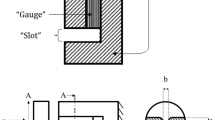Abstract
Modifications were made on the traditional split Hopkinson pressure bar (SHPB) system to conduct dynamic shear tests. The shear response of Ti-6Al-4V was acquired at a shear strain rate of 104 s−1 by using this modified apparatus. The geometry as well as the clamping mode of the double-notch specimen was optimized by commercial FEM software ABAQUS, and the feasibility of the experiment set-up was validated. A shear stress calibration coefficient of λ̄ τ = 1.03 and a shear strain calibration coefficient of λ̄ τ = 0.50 were obtained. We have employed highspeed photography to record the deformation process, especially the initiation and propagation of adiabatic shear band (ASB), during the dynamic shear test. The frames show that the time duration from ASB initiation to its completion is less than 2 μs, from which we can estimate that the propagation speed of ASB within Ti-6Al-4V is more than 1250 m/s under such loading conditions. The temperature rise within ASB is also estimated to be ΔT2 ≈ 1460 °C based on energy balance. Such high temperature has led to softening of the material within the ASBs, and has intensified the shear localization and finally resulted in fracture of the material.
Similar content being viewed by others
References
Wright, T.W., The Physics and Mathematics of Adiabatic Shear Bands. Cambridge, New York, Port Melbourne, Madrid, Cape Town: Cambridge University Press, 2002.
Bai, Y.L. and Dodd, B., Adiabatic Shear Localization, Occrrence, Theories and Applications. Oxford, New York, Seoul, Tokyo: Pergamon Press, 1992.
Hopkinson, B., A method of measuring the pressure in the deformation of high explosives by the impact of bullets. Philosophical Transactions of the Royal Society of London A, 1914, 213: 437–452.
Kolsky, H., An investigation of the mechanical properties of materials at very rates of loading. In: Proceedings of the Physical Society B, London, 1949.
Harding, J., Wood, E.D. and Campbell, J.D., Tensile testing of materials at impact rates of strain. Journal of Mechanical Engineering Science, 1960, 2: 88–96.
Duffy, J., Campbell, J.D. and Hawley, R.H., On the use of a torsional split Hopkinson bar to study rate effects in 1100–0 aluminium. Journal of Applied Mechanics, 1971, 38: 83–91.
Ferguson, W.G., Hauser, J.E. and Dorn, J.E., The dynamic punching of metals, dislocation damping in zinc single crystals. British Journal of Applied Physics, 1967, 18: 411–417.
Compbell, J.D. and Ferguson, W.G., The temperature and strain rate dependence of shear strength of mild steel. Philosophical Magazine, 1970, 21: 63–82.
Harding, J. and Huddart, J., The use of the double-notch shear test in determining the mechanical properties of uranium at very high rates of strain. In: Proc. 2nd International Conf. Mechanical properties at high rates of strain, 1979: 13.
Nemat-Nasser, S., ed., Mechanical Testing and Evaluation. ASM Metals Handbook, ASM International, 2000: 991–992.
Klepaczko, J.R., An experimental technique for shear testing at high and very high strain rates. The case of a mild steel. International Journal of Impact Engineering, 1994, 15(1): 25–39.
Rusinek, A. and Klepaczko, J.R., Shear testing of a sheet steel at wide range of strain rates and a constitutive relation with strain-rate and temperature dependence of the flow stress. International Journal of Plasticity, 2001. 17(1): 87–115.
Seo, S., Min, O. and Yang, H., Constitutive equation for Ti-6Al-4V at high temperatures measured using the SHPB technique. International Journal of Impact Engineering, 2005, 31: 20.
Wang, B.F. and Yang, Y., Microstructure evolutin of adiabatic shear bands in TC16 titanium alloy. The Chinese Journal of Nonferrous Metals, 2007, 17(11): 1767–1772.
Meyers, M.A., et al., Microstructural evolution in adiabatic shear localization in stainless steel. Acta Materialia, 2003, 51(5): 1307–1325.
Ranc, N., et al., Temperature field measurement in titanium alloy during high strain rate loading-Adiabatic shear bands phenomenon. Mechanics of Materials, 2008, 40(4–5): 255–270.
Author information
Authors and Affiliations
Corresponding author
Additional information
Project supported by National Natural Science Foundation of China (Nos. 11102166 and 10932008), the 111 project (No. B07050), and the Basic Research Foundation of NPU (No. JC201201).
Rights and permissions
About this article
Cite this article
Guo, Y., Li, Y. A Novel Approach to Testing the Dynamic Shear Response of Ti-6Al-4V. Acta Mech. Solida Sin. 25, 299–311 (2012). https://doi.org/10.1016/S0894-9166(12)60027-5
Received:
Revised:
Published:
Issue Date:
DOI: https://doi.org/10.1016/S0894-9166(12)60027-5




